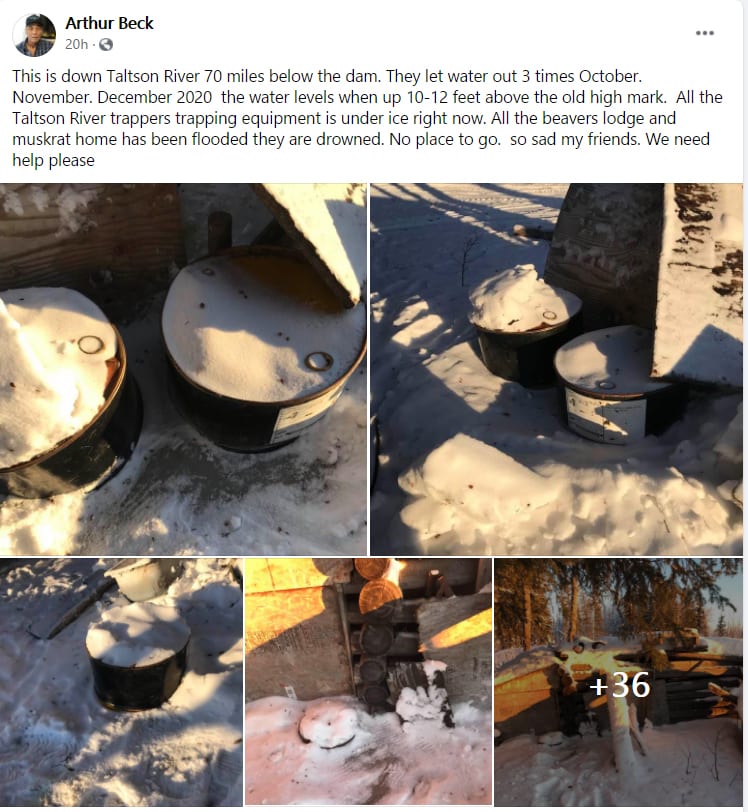A former president of the Fort Resolution Metis Council is calling attention to the extent of high water levels on the Taltson River this week, but the Government of the Northwest Territories says the situation is consistent with the unprecedented levels of water in the South Slave since summer.

image sourced from Facebook
Arthur Beck posted a widely shared statement on Thursday that shows a cabin and several pieces of equipment south of the Taltson Dam heavily flooded by high water levels. NNSL Media left a message with Beck on Friday, but he wasn't available for an interview.
Darren Campbell, a spokesperson with the Department of Environment and Natural Resources, stated that "unprecedented" high water levels have been recorded in the area for months.
"Water levels on the Taltson River, as well as on the Slave River, Hay River and Great Slave Lake have been high since the summer," said Campbell. "Flows on the Tazin River, tributary to the Taltson River, were more than six times higher than average in October 2020 –reporting at 372 cubic metres per second (m3/s) versus an average of 60 m3/s. "
Campbell added that in November, the department had let the public know with a public service announcement that there were higher than normal water levels and flow rates on many lakes, rivers and streams due to heavy summer precipitation.
"The announcement cautioned that the conditions would remain into the fall and winter, and could lead to changes in water overflow on land and ice," Campbell stated.
In November, the Taltson River was almost three times higher than average – reporting at 628 m3/s versus an average of 215 m3/s). Flows on the Taltson River have dropped since November, reporting at 524 m3/s as of January 22, 2021, according to Campbell.
He said the department is continuing to gather information about the Taltson River and looking into specific causes of flooding. More regular news releases will be forthcoming, similar to recent notices about Great Slave Lake, Hay River and Slave River, he added.
Land users to be consulted
The department was also asked about the impact that these conditions had on the traditional economy and Indigenous peoples who use the area for trapping, hunting and fishing.
Campbell said staff will be travelling to Fort Resolution and Taltson River "to collect data and speak with local trappers and land users.
"Staff will meet with them to discuss the scope and impact of the flooding, and ENR will continue to support trappers as much as possible as trapping is a vital part of the NWT’s culture and economy," he stated. "ENR officers will be travelling to some of the impacted sites with local residents over the weekend by snow machine and aircraft to better understand the scope of the impacts."
Power corporation says it's not at fault
Doug Prendergast, spokesperson with Northwest Territories Power Corporation, which manages the Taltson Hydro dam north of Fort Smith, said operations at the facility had no bearing on the massive washouts.

NNSL file photo
"High-water levels in the Taltson River are the result of natural river flow and not a result of NTPC's operations," Prendergast stated. "In December 2020, Taltson River water flows were higher than has been recorded in more than 50 years.
"There were no planned or unplanned water releases from the Taltson facility that would have resulted in higher downstream water levels."
Prendergast added that there were also no other operational changes at the facility that would have led to an impact on water levels.
"During 2020, the facility continued to operate similar to a run-of-river generation facility and in compliance with the terms and conditions of NTPC's licences and permits," he stated.
MLA seeking input
Prendergast stated that NTPC has been in contact with several land users including hunters and trappers who are concerned about the company's hydro operations potentially causing high water levels downstream.
"They were reassured that high-water levels in the Taltson River were the result of natural river flow and not a result of NTPC's operations," Prendergast stated.
Steve Norn, MLA for Tu Nedhe-Wilideh, is aiming to gather more information to raise the issue in the NWT Legislative Assembly and aims to address it with the media at a future date.
"Yes, this is definitely on my radar and something I will speak to in the house," he stated in an email. "I am still gathering info from some of the affected hunters and trappers in the area. I will also need to get historical data from the Elders about the flooded area."
Fort Resolution Metis Council President Louis Cardinal, Deninu First Nation Chief Louis Balsillie and Hamlet of Fort Resolution Mayor Patrick Simon couldn't be reached for comment by end of Friday.